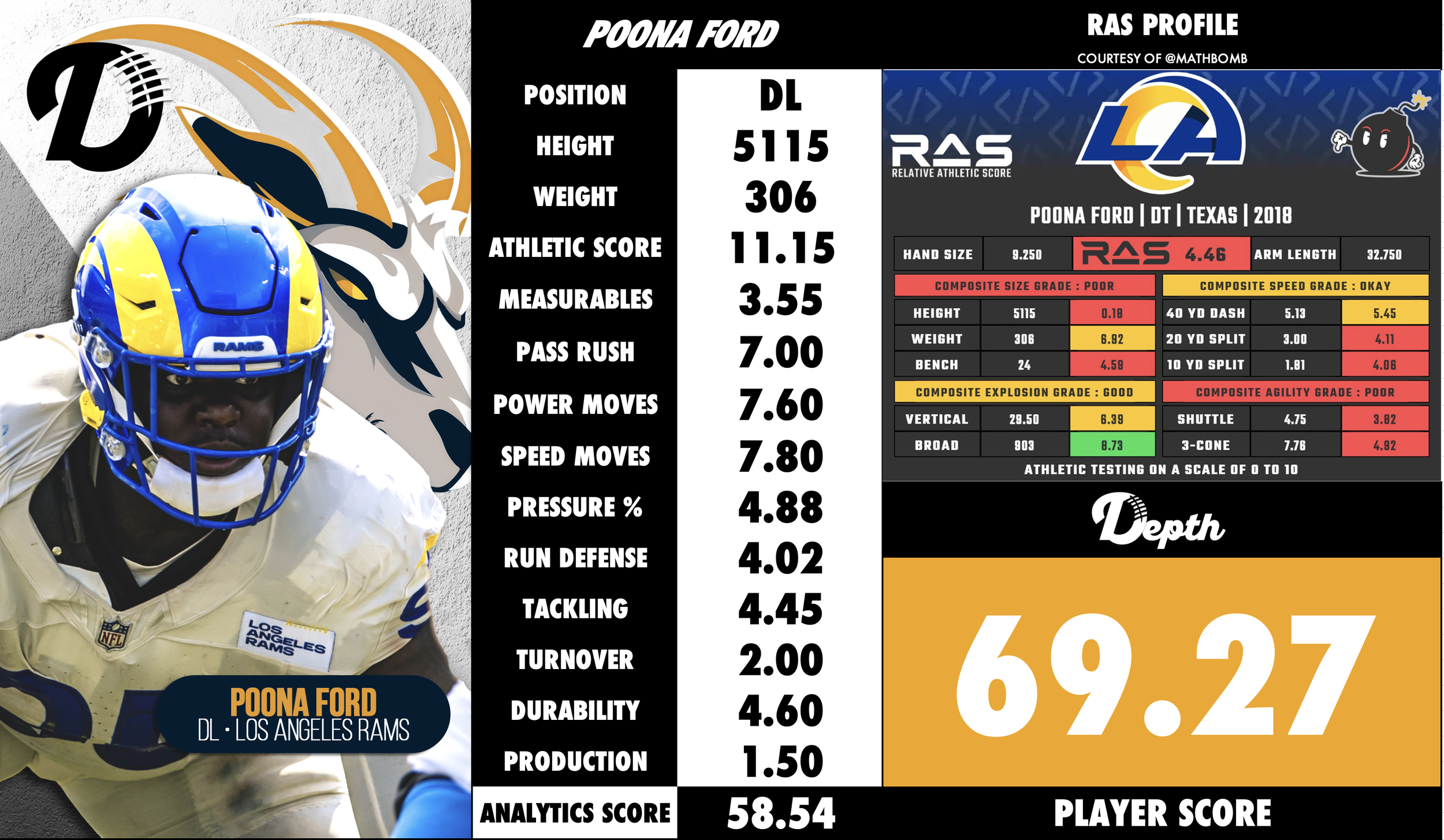
Poona Ford
Summary
Poona Ford went undrafted in the 2018 Draft out of University of Texas. Ford entered the NFL as a compact, low-centered defensive tackle (listed at 5′11″, ~310 lbs) who earned Big 12 Defensive Lineman of the Year honors in 2017 at Texas. Despite being overlooked in the draft due to his size, Ford demonstrated strong ability to gain leverage, anchor gaps, and disrupt plays from the interior. His career has been defined by his run-stop prowess, positional versatility, work ethic, and ability to turn a perceived disadvantage (his height) into a leverage benefit.
Strengths
Elite leverage and low-pad base at the point of attack: Ford’s height and stance give him a natural leverage advantage versus many offensive linemen. Bleacher Report
Efficient run-defender and gap-control specialist: He’s regularly flagged for his ability to “get in the blocker’s chest, maintain his position, and collapse the A-gap” on running plays. Sports Forecaster
Strong hand usage and power strikes inside: Boasts a heavy punch and ability to drive back blockers when given a favorable angle. CBS Sports
Good short-area explosiveness and initial burst: Even with his non-prototype height, Ford shows quickness off the snap and ability to penetrate inside.
High motor, positional versatility, and proven production: He played multiple interior alignments in college and has translated into a starter/regular contributor in the NFL despite being undrafted. Bleacher Report
Weaknesses
Below-prototypical height and arm length for interior line: Built like a fire hydrant; his listed height (5′11″) and measured arm length (32 ¾″) were cited as limitations by teams during the draft process.
Power anchor inconsistencies against double teams or drive blocks: At times he is washed out or driven back when facing heavier or multiple blockers due to the size mismatch.
Agility and change-of-direction in space are average: While his burst is good, his lateral ability and ability to mirror in space (for example when asked to chase or work to the second level) were flagged as less refined.
Limited pass-rush profile relative to premier interior disruptors: While he can penetrate and has some hurry-type plays, his sack/pressure numbers are modest compared to elite interior pass-rushers. CBS Sports
Ceiling sensitive to scheme and role usage: Because his best traits are leverage, gap control and run stopping rather than overwhelming size or speed, his impact is heavily dependent on being used in the right fits.
Fit & Outlook
Ford fits best in a defensive scheme that values a stout interior presence—particularly one-gap or slant type systems where the defensive tackle is tasked with penetrating or controlling the A-gap rather than anchoring two-gaps repeatedly or being the primary edge rusher. Schemes which allow him to use his leverage (low posture, short area explosion), align him as a 0- or 1-tech, rotate him as a run-stop specialist, or deploy him in sub-packages will maximize his strengths. He is less optimally utilized in schemes that demand constant lateral chase, long-body mirror techniques, or dominant size against two-gap blocks. Looking ahead, Ford’s outlook is favorable. His floor is as a reliable starting interior lineman who can hold the point of attack, contribute significantly to run-defense, and absorb blocks—offering strong value given his undrafted-entry. His upside includes evolving into a top-tier run-defender and rotational interior disruptor if he continues refining his hand technique, improves pass-rush moves, and is placed in a scheme aligned to his strengths. The biggest variables will be whether his size/length limitations ever become exploitable at an elite level, how durable he remains given his high-leverage style, and how his role evolves as offenses adapt their line play. Overall, Ford offers a high-character, proven performer who overcame draft biases and established a strong professional foundation.


